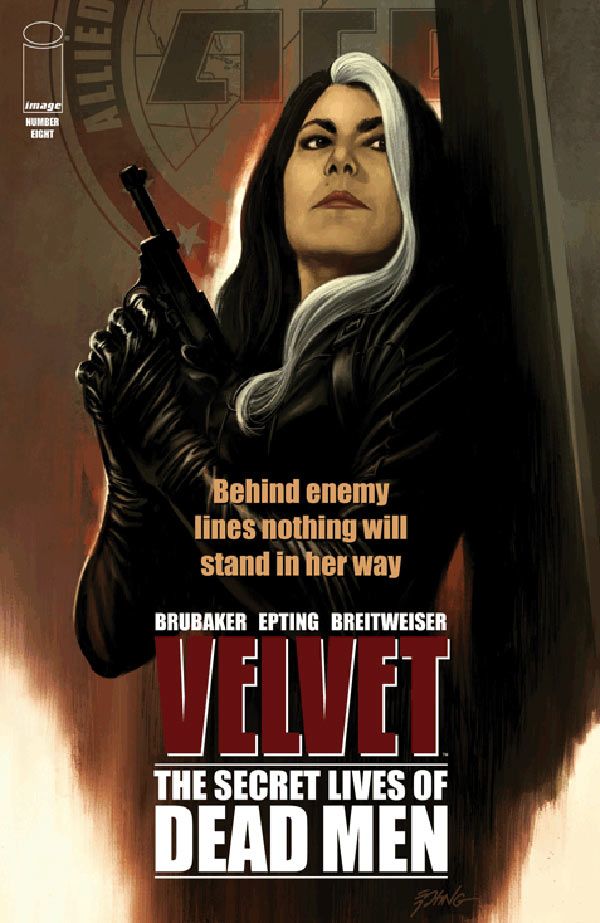In "Velvet" #8 by Ed Brubaker and Steve Epting, Velvet has succeeded in emptying the ARC-7 headquarters and has the run of the place for only a few precious minutes.
Brubaker ended "Velvet" #7 with the unforeseen twist of a bomb threat. Brubaker doesn't squander any of the energy of this cliffhanger in the first scene of "Velvet" #8, as he shows how Velvet gets into the building even while it's under lockdown. Just as Velvet relaxes, Brubaker ratchets up the suspense again when Sgt. Roberts calls her bluff.
This particular suspense trajectory is classic, most often used in television episodes as a teaser right before the opening theme rolls. While it's nothing new, it's very well-executed, especially since at this point the reader knows nothing about how Velvet set all this up, or why Roberts is onto her. Brubaker proceeds into flashback mode, giving the readers all of these answers in a satisfying way. All the puzzle pieces add up. Halfway through "Velvet" #8, the reader is back in the opening scene without a hitch in the transitions or the pacing. Brubaker's pacing is crisp and to the point. Epting's facial expressions give depth to Velvet's conversation with the Director, showing the regret and doubt underneath her upbeat and controlled demeanor.
While "Velvet" #7 was a great look into how two of the agents hunting Velvet thought of her and the whole situation, it's also a pleasure that Brubaker has switched back to Velvet's first person point of view. It's comforting to hear the wry humor in Velvet's voice again as she confides in the reader like a friend. As she deadpans, "bombs will make even an angry old man cooperative," it's hard not to laugh, especially since Epting has drawn the frowny-faced Director in the car alongside Velvet's voiceover.
As a protagonist, Velvet inspires trust. While the rest of the world doubts her loyalty, her innocence and her sanity, Brubaker gives the reader enough access to the character that there's little doubt in the reader's mind on those points, even though Brubaker holds back enough that the reader never knows exactly what Velvet's next move will be, until she puts her plans into action.
The last few issues have been moodier and slower as Brubaker fleshed out some of Velvet's past in multiple flashbacks while a detached cat-and-mouse chase played out in present time, so it's a good change that this issue is all action that leads somewhere, including some hand to hand combat. The central fight scene is a full four pages, but is tightly written and drawn. Epting's camera angles and reaction shots make the injuries count. While Sgt. Roberts and Velvet are both experienced agents, neither of them is young or super-powered, and Epting makes their physical vulnerability clear to the reader. When a gunshot is fired and when a blow lands on flesh, it feels harsh and dangerous, not only Velvet but for her opponent too.
Breitweiser's color work is subtle as usual. It's never distracting, and at the appropriate times, it reinforces and enhances the impact of Epting's art. She doesn't showboat, always keeping the look gray and quiet to fit the noir genre, but when she chooses to drop in some color, it's beautiful, like in the scene in the basement in which a spotlight casts overlapping prisms of peach and yellow light across the surface of a table and wall.
The final scene promises lots of juicy developments once Velvet's motorbike catches up with the car of the Cornwell Institute. The Mona Lisa smile of the unnamed former agent in the straitjacket is a wonderful bit of storytelling. With one facial expression, Brubaker and Epting indicate that despite what his guards think, he's neither crazy nor catatonic, and that he knows what Velvet's pursuit means. "Velvet" #8 is suspenseful from start to finish due to great creative teamwork between Brubaker's taut prose and plotting and Epting's dynamic and expressive artwork.

